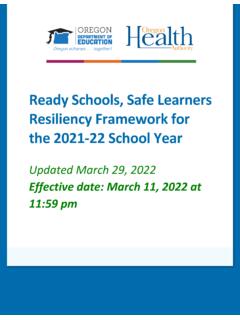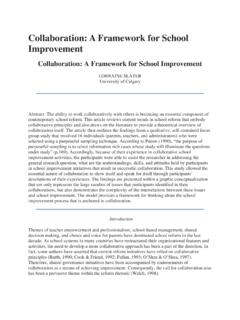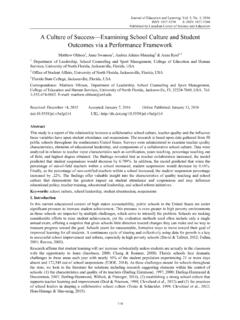Transcription of An Integrated Scheme for School Education
1 DRAFT DOCUMENT 1 SAMAGRA SHIKSHA An Integrated Scheme for School Education FRAMEWORK FOR IMPLEMENTATION Ministry of Human Resource Development Department of School Education and Literacy DRAFT DOCUMENT 2 CONTENTS CHAPTER 1 Introduction .. 3 Chapter 2 School Access, Infrastructure Development and Retention .. 9 Chapter 3 Addressing Gender and Equity issues in School Education .. 39 Chapter 4 Inclusion of Children with Special Needs in Education .. 60 Chapter 5 Quality Interventions .. 71 Chapter 6 Teacher Education and Teacher Training .. 96 Chapter 7 Information and Communication Technology (ICT) in School Education .. 127 Chapter 8 Vocationalisation of School Education .. 138 Chapter 9 Pre- School Education .. 152 Chapter 10 Programme Management.
2 161 List of Annexures Annexure I: framework Norms for Intervention for Infrastructure Development and Maintenance Under Samagra Shiksha .. 30 Annexure-II: Girls Hostel (As per norms for KGBV / Girls Hostel) .. 37 ANNEXURE-III: Guidelines for appointment of special educators .. 67 Annexure-IV: Guidelines for conducting written examination for Persons with disabilities .. 68 Annexure-V(a): Infrastructural Requirement for SCERT Model 1 .. 123 Annexure-V(b):Infrastructural Requirement for SCERT Model 2 .. 124 Annexure-VI: Suggested Physical Norms for the buildings of a DIET .. 125 Annexure-VII: Curriculum Framework: Two-Year Programme (by NCTE) .. 137 Annexure-VII: Results Framework Monitoring Implementation of RTE Act 2009 (RFD for Elementary Education ).
3 187 Annexure-VIII: Results Framework Document for Planning and Monitoring Outcomes of the Samagra Shiksha .. 191 Appendix: Programmatic and Financial Norms for the Components under the 197 DRAFT DOCUMENT 3 CHAPTER 1 INTRODUCTION Background Education is the most important tool for social, economic and political transformation and a key instrument for building an equitable society. A well-educated population, equipped with the relevant knowledge, attitudes and skills is essential for economic and social development in the twenty-first century. Education also acts as an integrative force in society, imparting values that foster social cohesion and national identity1. Before 1976, Education was the exclusive responsibility of the States.
4 The Constitutional Amendment of 1976 included Education in the Concurrent List. While the role and responsibility of the States in Education remained largely unchanged, the Union Government accepted a larger responsibility of reinforcing the national and Integrated character of Education , maintaining quality and standards including those of the teaching profession at all levels, and the study and monitoring of the educational requirements of the country. With the formulation of National Policy on Education (NPE), 1986, India initiated a wide range of programmes for achieving the goal of Universalisation of Elementary Education (UEE).These efforts were intensified in the 1980s and 1990s through several schematic and programme interventions, such as Operation Black Board (OBB), Shiksha Karmi Project (SKP), Andhra Pradesh Primary Education Project (APPEP), Bihar Education Project (BEP), Basic Education Project (UPBEP), Mahila Samakhya (MS), Lok Jumbish Project (LJP), District Primary Education Programme (DPEP) and the Sarva Shiksha Abhiyan (SSA) the flagship Centrally Sponsored Scheme in partnership with State Governments for UEE across the country.
5 This was further strengthened with the passage of the Right of Children to Free and Compulsory Education (RTE) Act, 2009 which gave a legal mandate to provide free and compulsory elementary Education to every child in the age group of 6-14 and UTs were supported in the implementation of the RTE Act, 2009 through the Centrally Sponsored Scheme of SSA. The norms of the Scheme were aligned with the provisions of the Act with effect from September, 2010. A successful programme of UEE is the precondition for taking the first reliable step towards Universal Secondary Education . The NPE emphasised improving equitable access to secondary Education and the enrolment of girls, SCs and STs, particularly in science, commerce and vocational streams (Para of the NPE, 1986).
6 The NPE and the Programme of Action (POA), 1992 while recognising secondary Education as a critical instrument for social change, called for its planned expansion. The NPE, (as modified in 1992) specifically laid emphasis again on increasing access to secondary Education with particular focus on participation of girls, SCs and STs; increased autonomy of Boards of Secondary Education to enhance their ability to improve quality; introduction of ICT in School curriculum for coping with globalisation; renewed emphasis on work ethos and values of a humane and composite culture in the curricula; and vocationalisation through specialised institutions or through the refashioning of secondary Education to meet the manpower requirements of the growing Indian economy (Para to ).
7 The Rashtriya Madhyamik Shiksha Abhiyan (RMSA) Scheme initiated in 2009, demonstrated the government s 1 India, Planning Commission, Twelfth Five Year Plan (2012-2017) Volume-III, p. 48 DRAFT DOCUMENT 4 ambition for a secondary Education system that can support India s growth and development. In the year 2013-14, four other Centrally-sponsored Schemes for secondary Education viz., ICT in Schools, Girls Hostel, Vocationalisation of Secondary and Senior Secondary Education and Inclusive Education for Disabled at Secondary Stage (IEDSS) were subsumed under RMSA. This was done to provide for convergence based implementation of different programmes for secondary Education with inclusion of aided schools for quality related interventions and Senior Secondary segment for certain components.
8 The Centrally Sponsored Scheme of Restructuring and Reorganization of Teacher Education (CSSTE) was initiated in 1987 pursuant to the formulation of the NPE, 1986. The NPE stated that improvement in the status and professional competence of teachers is the corner stone of educational reconstruction and envisaged teacher Education as a continuous process with pre-service and in-service training being its inseparable components. District Institute of Teacher Education (DIETs), Colleges of Teacher Education (CTEs), and Institutes of Advanced Studies in Education (IASEs) were, therefore, established. Thus, the CSSTE Scheme aimed to provide infrastructural and institutional support to Government Teacher Education Institutions (TEIs).
9 It is, therefore, evident that the Centrally Sponsored Schemes of SSA, RMSA and TE were the three major School Education development programmes of the Ministry of Human Resource development (MHRD), Government of India being implemented in partnership with State/UTs. The common objectives of all the Schemes are to enhance access through the expansion of quality School Education ; to promote equity through the inclusion of disadvantaged groups and weaker sections, and to improve the quality of Education for all. While the SSA covered the elementary level (grades I-VIII) and was the vehicle for implementation of the RTE Act, 2009, the RMSA covered grades IX-X (IX-XII for certain components.)
10 CSSTE provided for teachers Education through an institutional setup for both pre-service and in-service training across classes I-X. Further, with the role of SCERT as an academic authority u/s 29(1) of the RTE Act, the focus was on strengthening of SCERTs and DIETs. With the persistent efforts of the Central and the State Governments, these schemes have significantly addressed several major gaps in the School Education system and have significantly contributed towards laying a strong foundation for an equitable quality School Education system in the country. However, the major challenge is provision of quality Education . The focus of the Central Government is now on encouraging States to take steps for improvement in quality of Education .








